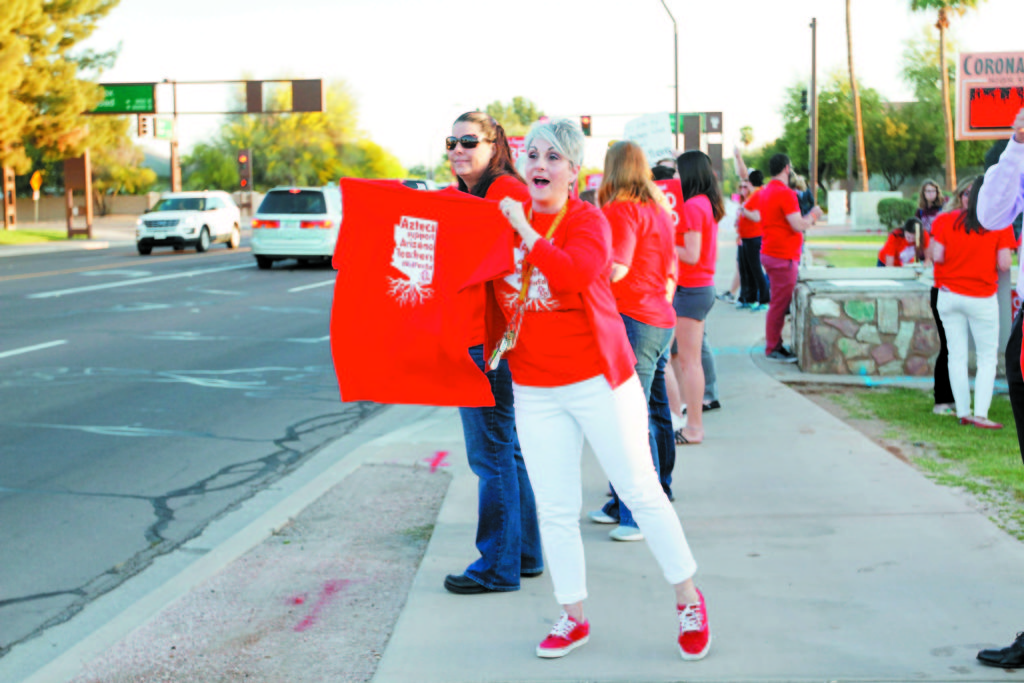
By Diana Whittle
In recent days, Arizona residents have witnessed the most dramatic display ever by public school educators—a walk off the job.
According to various media outlets whose reporters estimated the crowd’s size, nearly 50,000 protestors, most wearing bright red T-shirts, lined the streets of downtown Phoenix to march to the state capital. Among them: a huge contingent representing schools in Tempe and West Chandler.
Tension-filled news conferences by #RedForEd leaders and others gave early warning of the walk out. As a result, most districts in the state cancelled classes for Thursday and Friday, which reportedly affected approximately 850,000 students.
In Tempe and West Chandler, classrooms also remained empty on Monday.
Compensation for teachers and certified staff, along with competitive funding for support staff, remained the core complaint of the protests, as did some means to ensure adequate funding for classroom aides and learning materials, which some claim are woefully outdated.
By Friday afternoon, despite a message from the Governor’s Office to the contrary, a permanent deal between teachers, the Governor, and the legislators remains in question.
While the Governor agreed in theory to the 20 percent increase in compensation over a three-year period, no permanent funding source was identified; rather, the proposal relies on projected increases in state revenue.
Teachers remain unconvinced—they reason that by relying on a potentially volatile funding formula like growth, the necessary funding for education really will not be guaranteed—so educators pressed on with their strike as of Monday, April 30.
In another development on Friday, the AZ Center for Economic Progress, a progressive public policy group led by David Lujan, filed an alternative solution, which is an initiative measure to increase the income tax on upper-income earners to further fund teacher and classified staff raises.
The proposal, dubbed the “Invest in Education Act,” would increase the state’s 4.54 percent personal income tax rate to eight percent for those who earn more than $250,000 or whose household income reaches more than $500,000, and would double the rate to 9 percent for individuals who earn more than $500,000 or whose household income is greater than $1 million.
Under current law, someone with a taxable income of $600,000 pays $25,162. That same individual would pay $14,200 more if the measure is adopted.
The campaign’s supporters from the AZ Center for Economic Progress estimate the proposal would generate $690 million annually in new revenue and would serve as a permanent funding source for education. The initiative designates 60 percent of new funds for teacher salaries and 40 percent for district and charter school operation and maintenance expenses.
Ballot initiatives require a specific number of signatures by July 5 to qualify for the mid-term election in November, which is likely to happen says Dick Foreman, president of the Arizona Business and Education Coalition.
“#Red For Ed is an organic uprising that could lead to positive change in the state for education, as long as a dedicated revenue stream is identified,” said Foreman.
“Governor Ducey is offering a bold plan to improve education, but we can’t just bank on our economy to remain robust. We need funding that is consistent and permanent.
“The proposed initiative to increase personal income tax for wealthy individuals is one idea, but there are other revenue streams that could be also be identified and used. Arizona is a resource rich state and it’s up to residents to do more to support education.”
Other states including Oklahoma, Kansas, Nevada, Minnesota and Utah have passed various tax increases in recent years to re-invest in public schools.
In Tempe, at the Kyrene district, Superintendent Dr. Jan Vesely said during the last Governing Board meeting that she supports the teachers demands but, at the same time, realizes the hardships for families caused by closing the schools.
“I am fully endorsing the message that public education in Arizona is at a critical juncture. Without adequate funding for the classroom, we are unable to ensure that every child across the state has qualified teachers and instructional resources they need to deliver quality results.”
In a follow-up telephone conversation, Vesely expressed her gratitude to residents who have supported the district during this challenging time.
“We are very fortunate that the Kyrene community is incredibly supportive of education and our parents continue to understand that we made the difficult decision to close schools because of our inability to supervise our students or to ensure their safety,” said Vesely.
“Within the Kyrene budget, nearly 88 percent is already used for compensation; so, teachers want raises that are added into their base salaries so that they can also earn cost-of-living increases.
“We want money for schools to be restored to pre-2008 levels, which is when the recession hit Arizona. Since that time, schools have lost nearly half their per-pupil funding and for years teachers’ salaries were frozen,” said Vesely.
According to AZCentral.com, in the decade since recessionary times, Arizona legislators have cut public education funding by $1 billion. Previously, the state spent $924 more per student than it will in 2018.
As to when teachers and students will return to the classroom, Vesely admits that it is an hour-by hour wait-and-see event.
Her pledge is to keep families fully informed and she recommends visiting the district’s website for the most current information at: www.kyrene.org/schoolclosures

